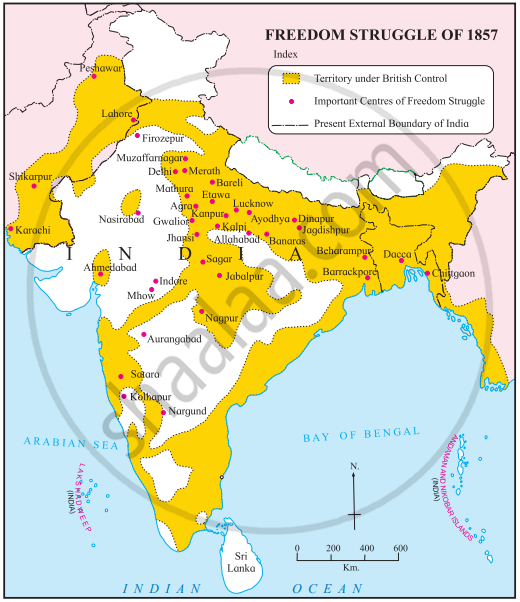Advertisements
Advertisements
Question
Identify the Acts passed in British India from 1858 to 1919, with a brief note on each.
Solution
The Government of India Act 1858, marked the beginning of a new chapter in the constitutional history of India.
Liquidation of East India Company and the powers of government, territories, and revenues were transferred to the British Crown.
The Indian Council Act, 1861
- It enabled the Governor-General to associate the people of the land with work of legislation.
- However, the legislative councils were merely talked shops with no power to criticize the administration or ask for some information. Their scope was fixed in legislation purpose alone; they had no right to move some kind of vote of no confidence.
The Indian Council Act, 1892
- This act marks the beginning of a representative form of Government in India.
- Indian National Congress had adopted some resolutions in its sessions in 1885 and 1889 and put its demand. The major demands placed were as follows:
- A simultaneous examination of ICS to be held in England and India
- Reforms of the legislative council and adoption of the principle of the election in place of nomination
- Opposition to the annexation of Upper Burma
- Reduction in the Military expenditure.
The Indian Councils Act, 1909 (The Morely-Minto Reforms)
- The British viceroy of India (1905-10) was able to introduce several important innovations into the legislative and administrative machinery of the British Indian government.
- The act also increased the maximum additional membership of the Imperial Legislative Council from 16 to 60.
The Government of India Act, 1919 (The Montague-Chelmsford Reforms)
- Subjects of administration were divided into two categories – ‘Central’ and ‘Provincial’. All important subjects (like Railways and Finance) were brought under the category of Central, while matters relating to the administration of the Provinces were classified as Provincial.
- The provincial subjects were divided into two groups viz. reserved and transferred.
- The reserved subjects were kept with the Governor and transferred subjects were kept with the Indian Ministers.
- This division of subjects was basically what they meant by introducing the Diarchy.
- The reserved subjects were the essential areas of law enforcement such as justice, police, and revenue. The transferred subjects were such as public health, public works, education, etc.
APPEARS IN
RELATED QUESTIONS
The British Commander of Kanpur killed by the rebels during the 1857 Rebellion was ______.
Who was Tantia Tope?
Prepare an album with pictures of frontline leaders of all the anti-colonial struggles launched against the British.
Indian Historians describe the revolt of 1857 as ______.
In November 1858 the power to govern India was transferred from ______ to the British Crown.
The Kingdom of Jhansi was annexed under ______.
What were the grievances of the company regarding the Nawabs of Bengal?
What were the consequences of the 1857 Revolt?
Observe the map and answer the questions based on it.

- Which were the important centers of freedom struggle of 1857, located in Pakistan?
- Which were the important centers of freedom struggle of 1857, located in Bangladesh?
- Which were the important centers of freedom struggle of 1857, located in Maharashtra?
- Which states were annexed by the British under the policy of Doctrine of Lapse?
- Mangal Pandey was posted in which cantonment?
Observe the given map and answer the questions based on it:

- To which topic is this map related?
- Name any one centre of the independence struggle of 1857 in present Bangladesh.
- Name any one centre of the independence struggle of 1857 in present Pakistan.
- Name any one place of the independence struggle of 1857 in present Maharashtra.
- Name the Indian island located in the Arabian Sea.
